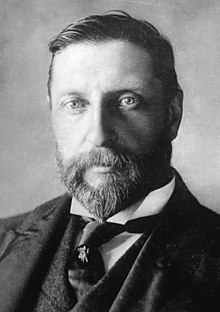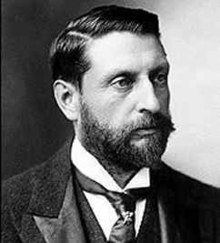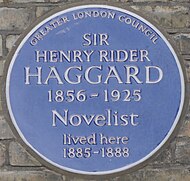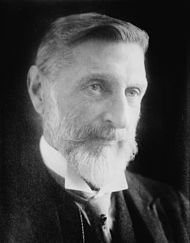H. Rider Haggard
H. Rider Haggard | |
|---|---|
 Haggard,c. 1905 | |
| Born | Henry Rider Haggard 22 June 1856 Bradenham,Norfolk,England |
| Died | 14 May 1925(aged 68) Marylebone,London, England |
| Resting place | St. Mary's Church,Ditchingham,Norfolk, England |
| Occupation | Novelist, scholar |
| Period | 19th and 20th century |
| Genre | Adventure,fantasy,fables, romance,sci-fi,historical |
| Subject | Africa, Ancient Egypt |
| Notable works | King Solomon's Mines, Allan Quatermainseries, She |
| Signature | |
 | |
| Website | |
| www | |
Sir Henry Rider HaggardKBE(/ˈhæɡərd/;22 June 1856 – 14 May 1925) was an English writer ofadventure fictionromancesset in exotic locations, predominantly Africa, and a pioneer of thelost worldliterary genre.[1]He was also involved inland reformthroughout theBritish Empire.[2]His stories, situated at the lighter end ofVictorian literatureand including the eighteenAllan Quatermainstories beginning withKing Solomon's Mines,continue to be popular and influential.
Life and career
[edit]Family
[edit]Henry Rider Haggard, generally known as H. Rider Haggard or Rider Haggard, was born atBradenham, Norfolk,the eighth of ten children, to William Meybohm Rider Haggard, a barrister, and Ella Doveton, an author and poet.[3]His father was born inSaint Petersburg,Russia, in 1817 to British parents.[4]
A member of theHaggard family,he was the great-nephew of the ecclesiastical lawyerJohn Haggardand an uncle of the naval officer Admiral SirVernon Haggardand the diplomat SirGodfrey Haggard.[5]
Education
[edit]Haggard was initially sent toGarsingtonRectory in Oxfordshire to study underReverend H. J. Graham,but, unlike his elder brothers, who graduated from variousprivate schools,he attendedIpswich Grammar School.[6]This was because[7]his father, who perhaps regarded him as somebody who was not going to amount to much,[8]could no longer afford to maintain his expensive private education. After failing his armyentrance exam,he was sent to a privatecrammerin London to prepare for the entrance exam for theBritish Foreign Office,[6]which he never sat. During his two years in London he came into contact with people interested in the study ofpsychic phenomena.[9]

South Africa, 1875–1882
[edit]In 1875, Haggard's father sent him to what is now South Africa to take up an unpaid position as assistant to the secretary toSir Henry Bulwer,Lieutenant-Governor of theColony of Natal.[10]In 1876, he was transferred to the staff of SirTheophilus Shepstone,Special Commissioner for the Transvaal. It was in this role that Haggard was present inPretoriain April 1877 for the official announcement of the British annexation of theBoerRepublic of theTransvaal.Indeed, Haggard raised theUnion flagand read out much of theproclamationfollowing the loss of voice of the official originally entrusted with the duty.[11]
At about that time, Haggard fell in love with Mary Elizabeth "Lilly" Jackson, whom he intended to marry once he obtained paid employment in Africa. In 1878, he became Registrar of the High Court in the Transvaal, and wrote to his father informing him that he intended to return to England and marry her. His father forbade it until Haggard had made a career for himself, and by 1879 Jackson had married Frank Archer, a well-to-do banker. When Haggard eventually returned to England, he married a friend of his sister, Marianna Louisa Margitson (1859–1943) in 1880, and the couple travelled to Africa together. They had a son named Jack (born 1881, died ofmeaslesat age 10) and three daughters, Angela (b.1883), Dorothy (b.1884) and Lilias (b.1892).Lilias Rider Haggardbecame an author, editedThe Rabbit Skin CapandI Walked By Night,and wrote a biography of her father entitledThe Cloak That I Left(published in 1951).
In England, 1882–1925
[edit]
Moving back to England in 1882, the couple settled inDitchingham,Norfolk, Louisa Margitson's ancestral home. Later they lived inKessinglandand had connections with the church inBungay, Suffolk.Haggard turned to the study of law and wascalled to the barin 1884. His practice of law was desultory and much of his time was taken up by the writing of novels, which he saw as being more profitable. Haggard lived at 69 Gunterstone Road inHammersmith,London, from mid-1885 to circa April 1888. It was at this Hammersmith address that he completedKing Solomon's Mines(published September 1885).[12]
Haggard was heavily influenced by the larger-than-life adventurers whom he met incolonial Africa,most notablyFrederick SelousandFrederick Russell Burnham.He created hisAllan Quatermainadventures under their influence, during a time when great mineral wealth was being discovered in Africa, as well as the ruins of ancient lost civilisations of the continent such asGreat Zimbabwe.[13][14]
Three of his books,The Wizard(1896),Black Heart and White Heart; a Zulu Idyll(1896), andElissa; the Doom of Zimbabwe(1898), are dedicated to Burnham's daughter Nada, thefirst white childborn inBulawayo;she had been named after Haggard's 1892 bookNada the Lily.[15]Haggard belonged to theAthenaeum,Savile,andAuthors'clubs.[16]

Aid for Lilly Archer
[edit]Years later, when Haggard was a successful novelist, he was contacted by his former love, Lilly Archer, née Jackson. She had been deserted by her husband, who had embezzled funds entrusted to him and had fled bankrupt to Africa. Haggard installed her and her sons in a house and saw to the children's education. Lilly eventually followed her husband to Africa, where he infected her withsyphilisbefore dying of it himself. Lilly returned to England in late 1907, where Haggard again supported her until her death on 22 April 1909. These details were not generally known until the publication of Haggard's 1981 biography by Sydney Higgins.[17]
Writing career
[edit]After returning to England in 1882, Haggard published a book on the political situation in South Africa, as well as a handful of unsuccessful novels,[18]before writing the book for which he is most famous,King Solomon's Mines.He accepted a 10 percent royalty rather than £100 for the copyright.[19]
A sequel soon followed entitledAllan Quatermain,followed bySheand its sequelAyesha,swashbucklingadventure novelsset in the context of theScramble for Africa(although the action ofAyeshahappens inTibet). The hugely popularKing Solomon's Minesis sometimes considered the first of theLost Worldgenre.[20]Sheis generally considered to be one of the classics of imaginative literature,[21][22]and with 83 million copies sold by 1965, it is one of thebest-selling booksin history.[23]He is also remembered forNada the Lily(a tale of adventure among theZulus) and the epicVikingromanceEric Brighteyes.
His novels portray many of the stereotypes associated withcolonialism,yet they are unusual for the degree of sympathy with which the native populations are portrayed. Africans often play heroic roles in the novels, although the protagonists are typically European. Notable examples are the heroic Zulu warrior Umslopogaas, and Ignosi, the rightful king of Kukuanaland, inKing Solomon's Mines.Having developed an intense mutual friendship with the three Englishmen who help him regain his throne, he accepts their advice and abolishes witch-hunts and arbitrary capital punishment.
Three of Haggard's novels were written in collaboration with his friendAndrew Lang,who shared his interest in the spiritual realm and paranormal phenomena.
Haggard also wrote about agricultural and social reform, in part inspired by his experiences in Africa, but also based on what he saw in Europe. At the end of his life, he was a staunch opponent ofBolshevism,a position that he shared with his friendRudyard Kipling.The two had bonded upon Kipling's arrival at London in 1889, largely on the strength of their shared opinions, and remained lifelong friends.[24]
Public affairs
[edit]Haggard was involved in reforming agriculture and was a member of many commissions on land use and related affairs, work that involved several trips to theColonies and Dominions.[25]It eventually led to the passage of theDevelopment and Road Improvement Funds Act 1909.[26]
He stood unsuccessfully for Parliament as aConservativecandidate for theEastern division of Norfolkin the 1895 summer election, losing by 197 votes.[27] He was appointed aKnight Bachelorin 1912 and a Knight Commander of theOrder of the British Empirein the1919 New Year Honours.[28][29]
Death
[edit]Haggard died on 14 May 1925 inMarylebone,London,aged 68.[30][1]His ashes were buried at St Mary's Church, Ditchingham.[31]His papers are held at the Norfolk Record Office.[32][33]His relatives include the writerStephen Haggard(great-nephew), the directorPiers Haggard(great-great-nephew), and the actressDaisy Haggard(great-great-great-niece).[34]
Legacy
[edit]
Influence
[edit]PsychoanalystCarl Jungconsidered Ayesha, the female protagonist ofShe,to be a manifestation of theanima.[35]Herepithet"She Who Must Be Obeyed" is used by British authorJohn Mortimerin hisRumpole of the Baileyseries as the lead character's private name for his wife, Hilda, before whom he trembles at home (despite the fact that he is a barrister with some skill in court). Haggard'sLost Worldgenre influenced popular Americanpulp writerssuch asEdgar Rice Burroughs,Robert E. Howard,Talbot Mundy,Philip José Farmer,andAbraham Merritt.[36]Allan Quatermain,the adventure hero of eighteen novels and short stories beginning withKing Solomon's Mines(1885), was a template for the American characterIndiana Jones.[37][38][39]Quatermain has gained recent popularity thanks to being a main character in theLeague of Extraordinary Gentlemen.
Graham Greene,in an essay about Haggard, stated, "Enchantment is just what this writer exercised; he fixed pictures in our minds that thirty years have been unable to wear away."[40]Haggard was praised in 1965 byRoger Lancelyn Green,one of theOxfordInklings,as a writer of a consistently high level of "literary skill and sheer imaginative power" and a co-originator withRobert Louis Stevensonof theAge of the Story Tellers.[41]
On race
[edit]Rider Haggard's works have been criticised for their depictions of non-Europeans. In his non-fiction bookDecolonising the Mind,Kenyan authorNgũgĩ wa Thiong'orefers to Haggard, who he says was one of the canonical authors in primary and secondary school, as one of the "geniuses of racism."[42]Author and academicMicere Mugowrote in 1973 that reading the description of "an old African woman in Rider Haggard'sKing Solomon's Mineshad for a long time made her feel mortal terror whenever she encountered old African women. "[42]
Haggard's works include many positive views of Africans. He includes them as heroes in some of his stories. For instance, all the main characters inNada the Lilyare black, and the book is narrated by an African character, while in "Black Heart and White Heart: A Zulu Idyll"the" black-hearted "character is a white man, while the" white-hearted "(i.e. virtuous) character is black.
Haggard criticises the use of the word "nigger," and in non-fiction works likeCetywayo and His White Neighbours,he argues that natives should be allowed to retain their practices, including polygamy.[43]

Influence on children's literature in the 19th century
[edit]During the 19th century, Haggard was one of many individuals who contributed to children's literature.Morton N. CohendescribedKing Solomon's Minesas a story that has "universal interest, for grown-ups as well as youngsters".[44]Haggard himself wanted to write the book for boys, but it ultimately had an influence on children and adults around the world. Cohen explained, "King Solomon’s Mineswas being read in the public schools [and] aloud in class-rooms ".[44]
General influence and legacy
[edit]The first chapter of Haggard's bookPeople of the Mistis credited with inspiring the motto of theRoyal Air Force(formerly theRoyal Flying Corps),Per ardua ad astra.[45]
In 1925, his daughter Lilias commissioned a memorial window for Ditchingham Church, in his honour, fromJames Powell and Sons.[46]The design features the Pyramids, his farm in Africa, and Bungay as seen from the Vineyard Hills near his home.[46]
The Rider Haggard Society was founded in 1985. It publishes theHaggard Journalthree times a year.[47]
Works
[edit]Films based on Haggard's works
[edit]Haggard's writings have been turned into films many times including:
- King Solomon's Mines
- This novel has been adapted for film at least six times. The first version,King Solomon's Mines,directed byRobert Stevenson,premiered in 1937. The best known version premiered in 1950:King Solomon's Mines,directed byCompton BennettandAndrew Marton,was followed in 1959 by a sequel,Watusi.In 1979 a low-budget version directed byAlvin Rakoff,King Solomon's Treasure,combined bothKing Solomon's MinesandAllan Quatermainin one story. The 1985 filmKing Solomon's Mineswas a tongue-in-cheek comedy, with a 1987 sequel in the same vein,Allan Quatermain and the Lost City of Gold.Around the same time an Australian animated TV film came out asKing Solomon's Mines.In 2004 an American TV mini-series,King Solomon's MinesstarredPatrick Swayze.In 2008 a direct-to-video adaptation,Allan Quatermain and the Temple of Skulls,was released by Mark Atkins; it bore more resemblance toIndiana Jonesthan the novel.
- Shehas been adapted for film at least ten times, and was one of the earliest movies to be made:
- In 1899, asLa Colonne de feu(The Pillar of Fire), byGeorges Méliès.
- An American1911 versionstarredMarguerite Snow.
- A British-produced version appeared in 1916, and in 1917Valeska Surattappeared in a production for Fox which is lost.
- In 1925 a silent film ofShe,starringBetty Blythe,was produced with the active participation of Rider Haggard, who wrote the intertitles. This film combines elements from all the books in the series.
- The1935 version,filmed a decade later, featuredHelen Gahagan,Randolph Scott,Helen Mack,andNigel Bruce.The lost city of Kôr is set in theArctic,rather thanAfrica,and depicts the ancient civilisation in anArt Decostyle. The music is byMax Steiner.The screenplay combines elements from all the books in the series, includingWisdom's Daughter.In 2006,Legend FilmsandRay Harryhausenrestored andcolorizedthe film forDVDrelease, as it was originally intended.
- The 1965 filmShewas produced byHammer Film Productions;it starredUrsula Andressas Ayesha andJohn Richardsonas her reincarnated love, withPeter CushingandBernard Cribbinsas other members of the expedition.
- The 1984 adaptation ofShetook place in a post-apocalyptic setting, attempting to capitalize on the fame ofMad Max.
- In 2001, another adaptation was released direct-to-video withIan Duncanas Leo Vincey,Ophélie Winteras Ayesha andMarie Bäumeras Roxane.
- Dawn
- The filmDawnwas released in 1917, starringHubert CarterandAnnie Esmond.
- This book was filmed in 1912,[48]featuringMarguerite Snow,Florence La BadieandJames Cruze,in 1914 withConstance CrawleyandArthur Maude,[49]and in 1917 asHeart and Soul,starringTheda Barain the title role.[50]
- The 1917 American filmCleopatrawas based on Haggard's novel and other sources.
- The book was adapted into a 1921 Italiansilentdrama filmcalledThe Stronger Passion,[51]directed byHerbert Brenonand starringMarie DoroandSandro Salvini.[52]
- The novel was adapted into a 1922 South African film.[53]
- This novel was the basis of a script byLadislaus Vajda,for film-directorMichael Curtizin his 1924 Austrian epic known asDie Sklavenkönigin(Queen of the Slaves).[55]
- Allen Quatermain is the lead character in the filmLeague of Extraordianry Gentlemen(2003). Although the plot of this film is not found in any form in any of Haggard's work, the Quatermain in this file is explicitly meant to be Haggard's Quatermain.
Honours
[edit]The locality ofRider, British Columbia,was named after him. Rider Haggard Lane inKessingland,Suffolk, is located at his former home.
See also
[edit]- Jules Verne(1825–1905), like Boussenard, his French contemporary, also wrote of fantastic worlds, though some of these are considered to be morescience fictionin some of his works than others.Journey to the Center of the EarthandThe Mysterious Islandare novels that are similar in structure to the novels of Boussenard and Haggard.
- Louis Henri Boussenard(1847–1911), French author ofadventure novels,dubbed the French Rider Haggard during his lifetime.
- Pierre Benoit(1886–1962), French author whose novelL'Atlantideis similar toShe.
- Emilio Salgari(1862–1911), Italian author of adventure novels and founder of the adventure genre in Italy.
- Alexandre Dumas,père (1802–1870), French author of historical novels of high adventure.
- Anthony Hope(1863–1933), English author of adventure novels such asThe Prisoner of Zenda.
- P. C. Wren(1875–1941), British writer of adventure fiction. He is remembered best forBeau Geste,a much-filmed book of 1924 involving theFrench Foreign Legionin North Africa, and its sequels,Beau SabreurandBeau Ideal.
- Mythopoeia
- Theosophical fiction
References
[edit]Notes
- ^ab"Rider Haggard Dies in London Hospital. Author of 'She,' 'King Solomon's Mines' and Many Other Novels Was Nearly 69. He Was Knighted in 1912. An Authority on Agriculture and Sociology. Served on Government Missions".The New York Times.15 May 1925.Retrieved18 November2012.
- ^Watts, James (2021)."Land Reform, Henry Rider Haggard, and the Politics of Imperial Settlement, 1900–1920".The Historical Journal.65(2): 415–435.doi:10.1017/S0018246X21000613.ISSN0018-246X.
- ^"Lost Races, Forgotten Cities".Violetbooks. 14 May 1925. Archived fromthe originalon 15 June 2014.Retrieved15 May2014.
- ^"The Days of My Life, by H. Rider Haggard: CHAPTER 1".ebooks.adelaide.edu.au.Archived fromthe originalon 23 April 2016.Retrieved16 April2016.
- ^Burke, B.A Genealogical and Heraldic History of the Landed Gentry of Great Britain and Ireland,14th ed. (1925). Haggard of Bradenham, pp. 804-806.
- ^ab Haggard, H. Rider (1989). "Introduction and Chronology; by Dennis Butts. In".King Solomon's Mines.Oxford University Press. vii–xxviii.
- ^Haggard, H. Rider (2002). "H. Rider Haggard".King Solomon's Mines.Modern Library Paperback Edition. v.
- ^Haggard, H. Rider (2002). "H. Rider Haggard".King Solomon's Mines.Modern Library Paperback Edition. vi.
- ^H.d.R. [Memoir of Haggard]. In: Haggard, H. Rider (1957) Ayesha. London: Collins
- ^Haggard, H. Rider (2002). "H. Rider Haggard". King Solomon's Mines. Modern Library Paperback Edition. vi.
- ^Pakenham, Thomas (1992)The Scramble for Africa: White Man's Conquest of the Dark Continent from 1876–1912,Avon Books, New York.ISBN0-380-71999-1.
- ^Eagles, Dorothy, and Carnell, Hilary, eds. (1978)The Oxford Literary Guide to the British Isles,Oxford University PressISBN0-19-869123-8p. 188
- ^Mandiringana, E.; Stapleton, T. J. (1998). "The Literary Legacy of Frederick Courteney Selous".History in Africa.25.African Studies Association: 199–218.doi:10.2307/3172188.JSTOR3172188.S2CID161701151.
- ^Pearson, Edmund Lester."Theodore Roosevelt, Chapter XI: The Lion Hunter".Humanities Web. Archived fromthe originalon 24 March 2016.Retrieved18 December2006.
- ^Haggard 1926.
- ^"HAGGARD, Henry Rider".Who's Who.Vol. 59. 1907. p. 756.
- ^Higgins 1981.
- ^Ellis 1978,p. 89.
- ^Etherington 1984,p. 99.
- ^According to Robert E. Morsberger in the "Afterword" ofKing Solomon's Mines,The Reader's Digest (1993).
- ^"Supernatural Horror in Literature by H. P. Lovecraft".Archived fromthe originalon 22 August 2007.Retrieved12 September2009.
- ^H.P. Lovecraft has stated in his essaySupernatural Horror in Literature:The romantic, semi-Gothic, quasi-moral tradition here represented was carried far down the nineteenth century by such authors as Joseph Sheridan LeFanu, Wilkie Collins, the late Sir H. Rider Haggard (whose She is really remarkably good), Sir A. Conan Doyle, H. G. Wells, and Robert Louis Stevenson
- ^"Cinema: Waiting for Leo".TIME.17 September 1965. Archived fromthe originalon 12 March 2008.
- ^Kipling, Rudyard (1937).Something of Myself.London: Macmillan & Co.
- ^Cohen 1961,pp. 239–85.
- ^Cohen 1961,p. 178.
- ^Cohen 1961,pp. 157–58.
- ^"No. 28588".The London Gazette.8 March 1912. p. 1745.
- ^"No. 31114".The London Gazette(Supplement). 8 January 1919. p. 448.
- ^"Index entry".FreeBMD.ONS.Retrieved3 January2018.
- ^Higgins 1981,p. 241.
- ^Pocock 1993,p. 288.
- ^"Rider Haggard Papers".Norfolk Record Office.Retrieved20 March2013.
- ^"Daisy Haggard: 'If I had Botox, my career would be over'".The Guardian.8 December 2015.Retrieved29 April2021.
- ^Fike, Matthew A. (2015)."Encountering the Anima in Africa: H. Rider Haggard's She".Jungian Journal of Scholarly Studies.10.doi:10.29173/jjs50s.Retrieved29 April2023.
- ^See Lee Server, Encyclopedia of Pulp Fiction Writers (2002), pg.131.
- ^"TheRepublic Serialswere most strongly influenced by Sir Henry Rider Haggard's 'white man explores savage Africa' stories, in particularKing Solomon's Mines (1886)"
- ^"Star Wars Origins – Other Science Fiction Influences".
- ^"Based on a 1885 novel by Henry Rider HaggardArchived5 December 2008 at theWayback Machine,the exploits of Allan Quatermain have long served as a template for the Indiana Jones character. In this particular film, King Solomon's Mines (1950), Quatermain finds himself unwillingly thrust into a worldwide search for the legendary mines of King Solomon. The look and feel of Indiana and his past adventures are quite apparent here, and his new quest follows some very similar through lines. Like Quatermain, Jones is reluctantly forced into helping the Russians find the Lost Temple of Akator and the Crystal Skulls mentioned in the film's title. Both Quatermain and Jones are confronted by angry villagers and a myriad of dangerous booby traps. Look to King Solomon's Mines for a good idea on the feel and tone Lucas and Spielberg are after with their latest Indiana Jones outing ".
- ^Greene, Graham (1969).Rider Haggard's Secret.New York: Viking Press. pp. 209–214.
{{cite book}}:|work=ignored (help) - ^from the introduction to the 1965Everyman's Libraryedition of the one-volumeThe Prisoner of ZendaandRupert of HentzaubyAnthony Hope
- ^abThiong'o, Ngugi wa (1 January 1994).Decolonising the mind: the politics of language in African literature.East African Publishers. p. 18.ISBN9789966466846.
- ^"R. D. Mullen- The Books of H. Rider Haggard: A Chronological Survey".depauw.edu.Archivedfrom the original on 1 February 2024.Retrieved11 May2024.
- ^abCohen, Morton N., "The Tale of African Adventure." Rider Haggard: His Life and Works. New York: Walker and Company, 1961. 89–95. Print.
- ^"The Royal Air Force MottoThe Royal Air Force Motto".RAF. 25 April 2012. Archived fromthe originalon 1 December 2017.Retrieved10 June2012.
- ^ab"The List".Abbott and Holder Ltd.Archived fromthe originalon 5 December 2019.Retrieved6 December2019.
- ^Fergusson, James (2018)The Haggard Society.The Book Collector67 no.1 (spring) 97-99.
- ^"Jess".IMDb. 21 May 1912.
- ^"Jess".IMDb. 18 February 1914.
- ^"Heart and Soul".IMDb. 21 May 1917.
- ^"The Stronger Passion".IMDb. 1 May 1921.
- ^Journeys of Desirep.50
- ^"Swallow".IMDb. 20 July 1922.
- ^"Stella".IMDb. 1 January 2000.
- ^"The Moon of Israel".IMDb. 24 October 1924.
Bibliography
- Cohen, Morton Norton (1961).Rider Haggard His life and Works.New York: Walker and Company.
- Cox, Noel (2013).Sir Henry Rider Haggard: A collection of commentaries on his novels.Aberystwyth: CreateSpace Independent Publishing Platform.ISBN9781494397746.
- Ellis, Peter (1978).H. Rider Haggard: A Voice from the Infinite.Routledge.ISBN9780710211941.
- Etherington, Norman (1984).Rider Haggard.Twayne Publishers.ISBN9780805768695.
- Haggard, H. Rider (1926).The Days of My Life.Longmans.
- Higgins, D.S. (1981).Rider Haggard: The Great Storyteller.London: Cassell.ISBN0-304-30827-7.
- Katz, Wendy Roberta (2010).Rider Haggard and the Fiction of Empire: A Critical Study of British Imperial Fiction.Cambridge University Press.ISBN9780521131131.
- Klein, Darius M. Survivals and Origins in H. Rider Haggard'sShe: A History of Adventure--A bibliographyonline source of bibliography
- Monsman, Gerald Cornelius (2006).H. Rider Haggard on the imperial frontier.ELT Press.ISBN9780944318218.
- Pocock, Tom (1993).Rider Haggard: And the Lost Empire.Weidenfeld and Nicolson.ISBN9780297813088.
External links
[edit]- Works by H. Rider Haggard in eBook formatStandard Ebooks
- Works by H. Rider HaggardatProject Gutenberg
- Works by H. R. HaggardatProject Gutenberg Australia
- Works by H. R. HaggardatOne More Library
- The Mahatma and the Hare: a Dream Storyillustrated by William Thomas Horton(1911)
- Umslopogaas, She, & Allan Quatermain Full Series(1927)
- Works by or about H. Rider Haggardat theInternet Archive
- Works by H. Rider HaggardatLibriVox(public domain audiobooks)

- H. Rider Haggardat theInternet Speculative Fiction Database
- H. Rider Haggard'sShe,Escape,CBS radio,1948
- H. Rider Haggard Quotation Collection
- The Books of H. Rider Haggard: A Chronological Survey
- Rider Haggard Society
- Holterhoff, Kate."Visual Haggard: The Illustration Archive".Archived fromthe originalon 24 November 2018.Retrieved3 October2013.
- In and Out of Africa: The Adventures of H. Rider HaggardLilly Library,Bloomington, IN
- Camera Interviews – Sir Rider Haggard (1923),byPathé
- Finding aid to H. Rider Haggard papers at Columbia University. Rare Book & Manuscript Library.
- H. Rider Haggard
- 1856 births
- 1925 deaths
- Haggard family
- Fabulists
- English fantasy writers
- English historical novelists
- Writers of historical fiction set in antiquity
- Writers of historical fiction set in the Middle Ages
- Writers of historical fiction set in the early modern period
- Mythopoeic writers
- Legion of Frontiersmen members
- Knights Bachelor
- Knights Commander of the Order of the British Empire
- People educated at Ipswich School
- People from Breckland District
- Victorian novelists
- 19th-century British novelists
- 20th-century English novelists
- 19th-century British short story writers
- People from Ditchingham
- Writers of Gothic fiction
- English male novelists
